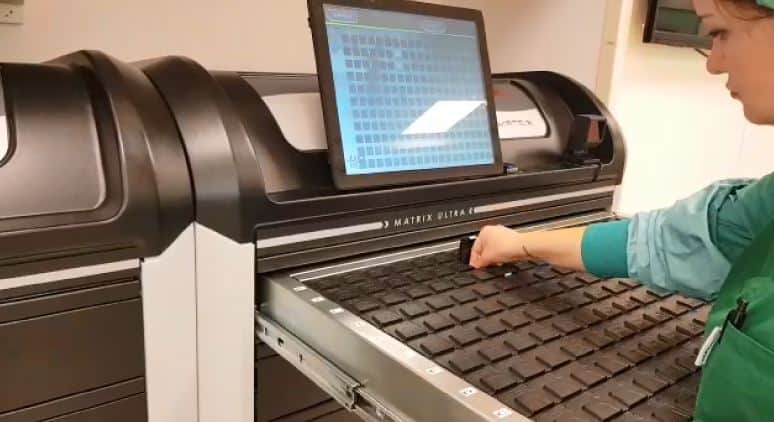What’s inside:
Automated pharmacy systems are becoming more common in the healthcare setting, in particular as part of the move towards decentralized dispensing.
This article looks at:
- Automated medication dispensing in surgical spaces
- The benefits of automated dispensing systems?
- What to look for when purchasing a new automated dispensing cabinet
The job of managing a hospital pharmacy has changed dramatically over recent years – two of the biggest changes have been the increased automation being used for medication management, as well as the move towards decentralized dispensing.
With so many big changes, it’s important for pharmacists to retain tight control of their medication inventory.
In this blog we take a look at how to make decentralized dispensing work well in practice.

Automated medication dispensing in surgical spaces
Automated medication dispensing machines are now commonly seen at the point of care, and are being used to store, dispense and manage medications in the surgical setting. Many healthcare providers actually have a smart narcotics cabinet in the OR, but our recent blog on the best location for dispensing cabinets, made our feelings on this very clear!
Decentralized dispensing can only work with a tight and well-defined partnership between clinicians and pharmacists. Each will need to play their own distinct role in the hospital pharmacy function.
The split between clinicians and pharmacists is typically set up as follows:
- The Pharmacist is responsible for the monitoring of usage and returns, as well as the re-stocking of supplies and handling of expired/recalled items.
- The Clinician is responsible for the dispensing of medication, as well as the return of unused drugs.
The best automated dispensing cabinets deal with this dual level of responsibility by having inbuilt rights for different users, so users set up as pharmacists have functionality that clinicians don’t have. This ensures the control and management of the cabinet sits firmly with the pharmacist.
The pharmacist will need to service each automated cabinet for controlled drugs by entering the operating room. The cabinet can then be restocked, any expired/recalled items can be removed, and returns can be validated and collected. As new stock is loaded onto the system it is allocated to the relevant cell and digitally recorded on the system so that it can be tracked.

What are the benefits of an automated dispensing system?
Not all healthcare providers currently have an automated dispensing solution. They may be using a manual cabinet to store and dispense medications needed in surgery or will have a centralized system where dispensing takes place in the pharmacy.
Let’s look at the advantages of automated medication management in healthcare using a decentralized model.
- Surgical medication dispensing: Having controlled drugs and narcotics close to the point of care reduces the time taken by clinicians to prepare the medications needed in surgery. This task no longer requires a trip to the pharmacy. At the end of surgery returns are also a local activity without the need to go to the pharmacy and await sign-off by the pharmacist.
- Improved inventory management: Pharmacists need to ensure the continued supply of medication and do do this they need to keep track of usage in all the decentralized dispensing points. The automated tracking of medication dispensing ensures that the Pharmacy Department is kept informed of the stock levels of each narcotics cabinet and can therefore arrange for prompt restocks that prevent stock-outs.
- Medication reports and data: The best narcotics management systems can generate metrics, reports and data insights. This valuable data enables the pharmacist to oversee inventory levels, monitor usage and ensure all users are accountable. The data informs pharmacy decision making, underpinning prompt cabinet restocks and medication reorders. This will result in a perpetual supply of all the medications needed in surgery.
- Narcotics security: The best automated dispensing systems have tight security. In addition to secure log-in arrangements, the safest systems provide single cell dispensing and returns. This gives complete tracking of usage, including which items were taken (or returned), and by who. Strong hardware, combined with smart software, is helping to prevent drugs diversion activity.
- Integrated pharmacy: Smart narcotics cabinets are able to integrate with the hospital ERP and EHR so that all vital information on medications and dispensing supports accurate charting, billing and inventory management.

What to look for when purchasing a new automated dispensing cabinet?
There are many automated medication dispensing systems on the market, but they are not all the same.
If you are looking to embrace pharmacy inventory management best practice and are trying to select a new medication management solution, we suggest you look for the following important criteria:
- Single cell dispensing – this really is the safest, most accountable method of tracking what has been taken and by who.
- Single cell returns – just as important – accountability needs to be embedded throughout the process, including the validated return of medications and many systems fall down in this important area.
- Ease of use – it’s the combination of software and hardware that affect usability. You don’t want to have to trawl through repetitive screens select a system with easy navigation and smooth workflows.
- Interoperability – sharing data with hospital systems is key – it supports perpetual inventory management, accurate charting and other functions, such as medical billing.
Find out more information in the Secure Narcotics Cabinet which has security features based on ASHP guidelines.
Contact us for a demo today.






